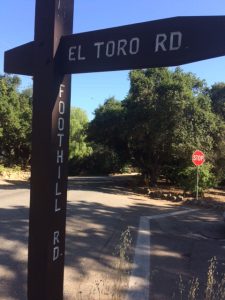The following article was written by Howard Bald and appeared in the April 25, 1973 edition of the Ojai Valley News. It is reprinted here with their permission. Photos have been added by the Ojai Valley Museum. Bald used the same title for his many articles. So the Ojai Valley Museum has added “(No. 3)” to this one.
Reminiscences of Early Ojai (No. 3)
by
Howard Bald
Presumably El Toro Road in the Arbolada got its name from the slaughter house that once existed in that vicinity just off Foothills Road. When people began to build along Foothills Road, the offensive slaughter house was moved to Del Norte Road across from the cemetery. All meat for the valley was dressed at the slaughter house.

Three times a week the meat wagon, a covered wagon drawn by two horses, made the round of the east end of the valley, stopping at all the homes and ranches in that vicinity. Among them were W.C. Hendrickson, Fred Udhall, Pierpont Cottages, Dr. Hollingsworth, the Lords (parents of Denham Lord), A.L. Dodge, Thacher School, the McAndrews, E.S. Thacher and the Jim Chapmans.
On the alternate day the wagon went to the Upper Ojai, and among those served were the Dennisons, Clarks, Hobarts, Thompsons, Robinsons, MacGuires, Grays, Burnells, Pinkertons and Brackens. There were doubtless others.
Annie Pinkerton always had a nice piece of pie for the meat man. Houk had a very good butcher, but he couldn’t resist Jimmie Braken’s wine at the upper end of his route. Fred Houk tells me that his father used to send him along to drive the team home when he had imbibed too heavily.
What I remember in particular was the butcher letting the wagon tail gate down (it served as a cutting and packaging block) and in the summer the flies swarming in. When the customer was served, the butcher with his flour sack apron would swish the flies away, then hurriedly close the end gate.
All that I remember about the price of meat was that 15 cents worth of round steak was sufficient for a family of four, with a tidbit for the family dog.
As well as I can remember, there was no regular dairy with milk delivery until about 1915-18. But a great many people had a family cow, sometimes two or three, and they would sell to neighbors a quart or so now and then. When there was a surplus of milk, some would make butter and exchange it for groceries. Since the churning and working of the butter was by hand, that is, separating the milk from the butter and molding it, and there was no refrigeration, the product very quickly became rancid. And of course, the milk would sour very readily. Among those that I delivered to were the Pratts, Libbeys and Robertsons.
Certain townspeople were essentially the same as of today. Now as I drive over those confusing roads, my wife wonders how I know where I am going. I reply that considering the dark nights I combed the park for a stray cow, I should know my way about.
And what I remember about sanitation, or lack of sanitation, in the production and handling of milk and butter would fill quite a volume. I am sure much of the same would apply to meat. I was familiar with that business for several years before the Houks came to Nordhoff and installed refrigeration.
The grocer did not dispense eggs in nice, clean cartons as we know them. Generally, the eggs were a week or more in accumulating. And generally they were fertile. There was no candling, so not infrequently an egg on being opened would reveal an embryo — not very appetizing.
One of the town rowdies could crow like a rooster, and in the middle of the night would get the many, many neighborhood roosters started to crowing, thus setting off a general chorus. Naturally he was not popular with the neighbors.

The mcandrew’s came
Down from Montana
After mining silver.
We grew oranges and
Absconding, which do
well in the ojai